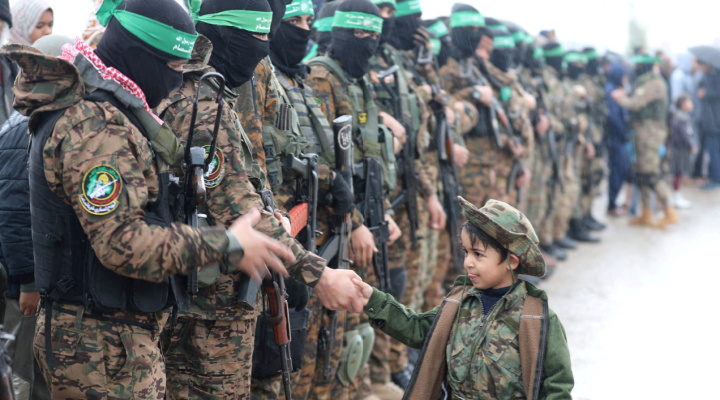A Palestinian Hamas terrorist shakes hands with a child as they stand guard as people gather on the day of the handover of Israeli hostages, as part of a ceasefire and a hostages-prisoners swap deal between Hamas and Israel, in Rafah in the southern Gaza Strip, Feb. 22, 2025. Photo: REUTERS/Ramadan Abed
Since assuming de facto control of Gaza in 2007, Hamas has increasingly restricted information sharing, creating a distorted media image that hides its crimes and portrays Israel as the primary antagonist.
Former Associated Press journalist Matti Friedman was the first to widely publicize Hamas’ media control in 2014, and it remains significant in 2025, overshadowing Israel’s sincere attempts at openness.
The extent of Hamas’ press control was highlighted in a 2022 Washington Times report, which noted that foreign journalists were barred from covering Gazans killed by misfired Palestinian rockets and required the press to attribute all casualties to Israel.
Hamas also ordered that all foreign correspondents employ Palestinian “sponsors,” who must submit full reports on where those correspondents go, what they do, and any “illogical questions” they ask.
Local journalists have been known to face extremely dangerous coercion — quite recently, in fact. The Jerusalem Post reported that in November 2023, Gaza journalist Tawfiq Abu Jarad was detained in Rafah by masked men claiming to be Hamas members, accused of reporting on civil unrest, and released only after promising to stop. In late April 2025, he received a threatening call warning him not to cover a female-led protest in Beit Lahia.
This is one of many stories that have been extensively documented.
Hamas’ grip on journalistic access extends beyond Gaza. Its influence shaped global reports such as the 2009 UN Fact-Finding Mission (the Goldstone Report), commissioned by the UN Human Rights Council after the 2008–2009 Gaza War. Former Israeli Ambassador Michael Oren criticized the report for relying heavily on Hamas-selected witnesses. The report ignored Hamas’s strategy of embedding militants in civilian populations and its intentional firing of over 7,000 rockets at Israeli civilian areas.
Another UN-related example occurred in 2022. UN official Sarah Muscroft, based in eastern Jerusalem, faced backlash after tweeting criticism of Palestinian Islamic Jihad’s indiscriminate rocket attacks. Pro-Palestinian activists accused her of “blaming the victim” despite the tweet’s factual basis, and she was transferred.
Hamas also manipulates imagery and stages photos. Friedman described cameramen at Al-Shifa Hospital being instructed to stop filming injured Hamas fighters, maintaining the illusion that only civilians were being hurt. Digital distortions have added new layers of misinformation. The New York Times and AP News reported in 2023 that the Gaza conflict produced AI-generated images of mutilated babies and recycled Syrian footage misattributed to Israel.
While some visuals were genuine, many were fabricated — distorted anatomy, mismatched lighting, and deepfake anomalies — designed to provoke outrage rather than report truth.
A telling contrast involves the “doll controversy.” In November 2023, The Jerusalem Post mistakenly claimed a viral image of a deceased Palestinian baby was a staged doll. The article was retracted and an apology issued on X (formerly Twitter) on December 2, after identifying the child as Muhammad Hani Al-Zahar, killed in an Israeli airstrike. This demonstrated commitment to transparency, even at reputational cost.
By contrast, Hamas’ falsehoods are rarely corrected and almost never acknowledged. A striking exception occurred in late 2023 when Hamas claimed — and the worldwide media dutifully reported — that an Israeli missile had struck a Gaza hospital and killed hundreds. It was later revealed to be an errant Palestinian missile, with a much lower death toll — but the damage was done, and the media issued half-hearted corrections, at best.
Hamas also releases distorted casualty numbers — which don’t separate terrorist fighters from the civilian population — and the media dutifully reports them.
Yet the world keeps falling for this, because most of the media plays along — whether out of fear, ideological bias, or pressure from NGOs hostile to Israel. Headlines scream “Israel Pounds Gaza,” omitting that rockets were launched from schools or hospitals. Israeli claims are often treated with suspicion until proven true, long after the narrative damage is done.
For meaningful change, the global media must treat Gaza as a theater of information warfare. Every image and interview should carry a digital asterisk. Verification must be standard — not optional. Truth requires context, not censorship.
The question is not whether Hamas lies — it lies, distorts, and controls information, even that of outsiders. The real question is: will the world keep rewarding the lie? History and ethics demand we stop doing so.
Alexander Mermelstein, a recent USC graduate with a Master’s in Public Policy and Data Science, is an aspiring policy researcher focused on Middle East affairs and combating antisemitism.
Click this link for the original source of this article.
Author: Alexander Mermelstein
This content is courtesy of, and owned and copyrighted by, https://www.algemeiner.com and its author. This content is made available by use of the public RSS feed offered by the host site and is used for educational purposes only. If you are the author or represent the host site and would like this content removed now and in the future, please contact USSANews.com using the email address in the Contact page found in the website menu.








